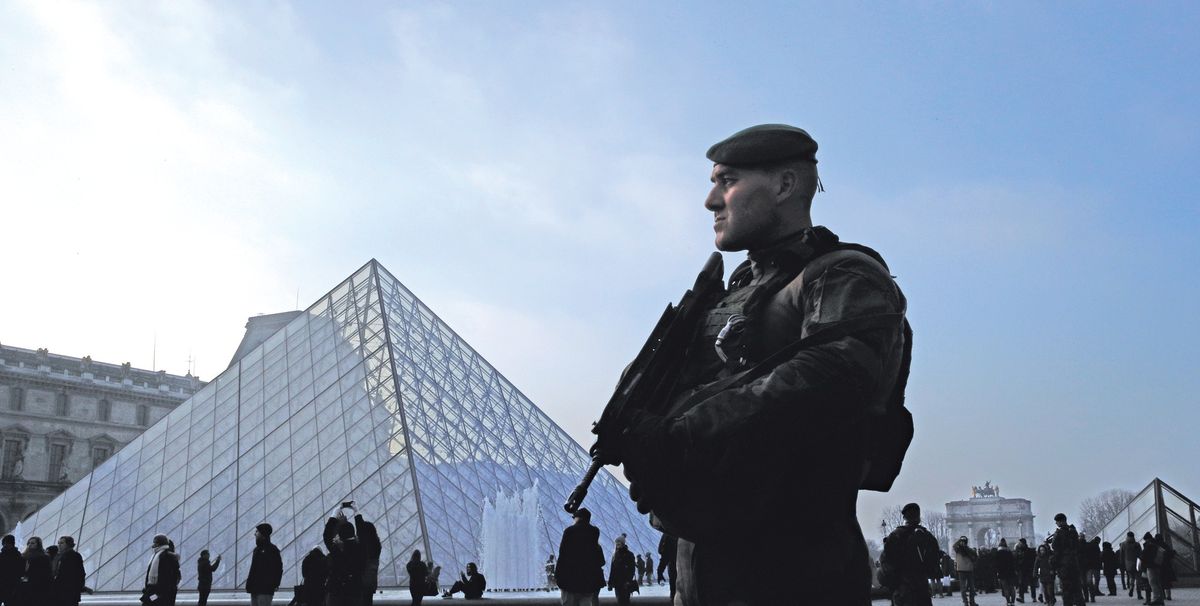In the wake of deadly terrorist attacks in Paris in November 2015 and Nice last July, tourists are staying away from the French capital—and museums are feeling the effects.
The Musée du Louvre, the world’s most visited art museum, attributed its 15% drop in attendance (from 8.6 million in 2015 to 7.3 million in 2016) to the “backdrop of a sharp fall in the number of foreign tourists”. Visitor numbers were down by 13% at the Musée d’Orsay (from 3.4 million to just under 3 million) and 10% at the Château de Versailles (from 7.4 million to 6.7 million). All three institutions are reporting multi-million euro losses linked to the slump—part of an estimated €1.5bn in lost business suffered by the wider region in 2016.
These shortfalls are compounded by the fact that museums have had to spend additional money to update security after the French president declared a nationwide state of emergency in the wake of the attacks. Versailles lost around €5m in ticket sales last year, but spent almost €1m on additional security; the Musée d’Orsay lost €4m and spent €1m on security (though it also received a €2m government grant for security improvements).
“The problem isn’t the attacks in themselves but the state of emergency,” says the French art critic Didier Rykner. “The Americans and Japanese are no longer insured in the same way and the embassies warn people not to go to France.” In December, the French parliament voted to extend the heightened security measures for the fifth time in order to cover the presidential campaign season.
But all is not doom and gloom. Versailles is expecting to receive “a small advance” from the government to help finance its 28 new guards, and attendance is bouncing back, according to Thierry Gausseron, the palace’s general administrator. The extra security has also enabled staff to open around 15 rooms to the public for the first time. “There are fewer people but there is more to see,” Gausseron says. “We hope quality and content will bring people back.”
The Louvre is also concentrating on improving the visitor experience. While attendance declined in 2016, satisfaction levels rose: almost 70% of visitors said they were “very satisfied” with the museum, compared with 53% the previous year. The museum attributes the rise to online ticketing and the €53.5m refurbishment of its I.M. Pei-designed Pyramid entrance.
The Louvre predicts it will take three years for attendance to return to its previous record levels, based on a similar drop in tourism in Paris after the September 11 attacks in New York in 2001. But expensive loan exhibitions such as Vermeer and the Masters of Genre Painting, which opens on 22 February (until 22 May), remain a priority.
“Everyone has to reduce their operations, but it is essential to maintain the quality of the shows because they drive the crowds more than ever,” says Laurent Le Bon, the director of the Musée Picasso Paris. The museum’s Picasso: Sculptures exhibition last summer was one of the most popular in its history, drawing 345,000 visitors, despite an overall decline of around 10% in attendance for the year. Meanwhile, some institutions have bucked the downturn entirely: the Centre Pompidou drew 9% more visitors in 2016 than in 2015, thanks to a loyal French following and crowd-pleasing exhibitions such as Magritte: La Trahison Des Images, which closed in January.
Looking ahead, institutions are trying to make up for budgetary shortfalls—and to engage potential visitors—by sending their collections on tour. The Musée d’Orsay plans to lend works to exhibitions in Taipei, Tokyo and Milan this year, while the Louvre is banking on major travelling shows in the US and China, with Japan and Latin America to follow. “The collections are our best ambassadors,” a spokeswoman says.
Some hope the attendance squeeze will also embolden museums to double down on their role as educational institutions, not tourist attractions. “Is a museum measured by the number of visitors it receives or the quality of what it presents?” Didier Rykner says. “Museums should focus on their job, to make beautiful exhibitions.”
Belgian museums lost one third of visitors in 2016Museums in Brussels closed for three days last March during a citywide lockdown after coordinated terrorist bombings killed 31 people. The Royal Museums of Fine Arts of Belgium lost around a third of its visitors in the immediate aftermath, a spokesman says. Total attendance figures for the six-museum complex reflect a similar trend throughout 2016: around 500,000 visitors came last year, compared to more than 750,000 in 2015. This translated into a loss of €1.2m in ticket sales and shop revenue. The federal government gave £50,000 to reinforce museum security in the first half of the year but has rejected a request to limit planned budget cuts to staff. Despite a difficult year, “we strongly believe that our museums are a powerful weapon against intolerance”, the spokesman says.


